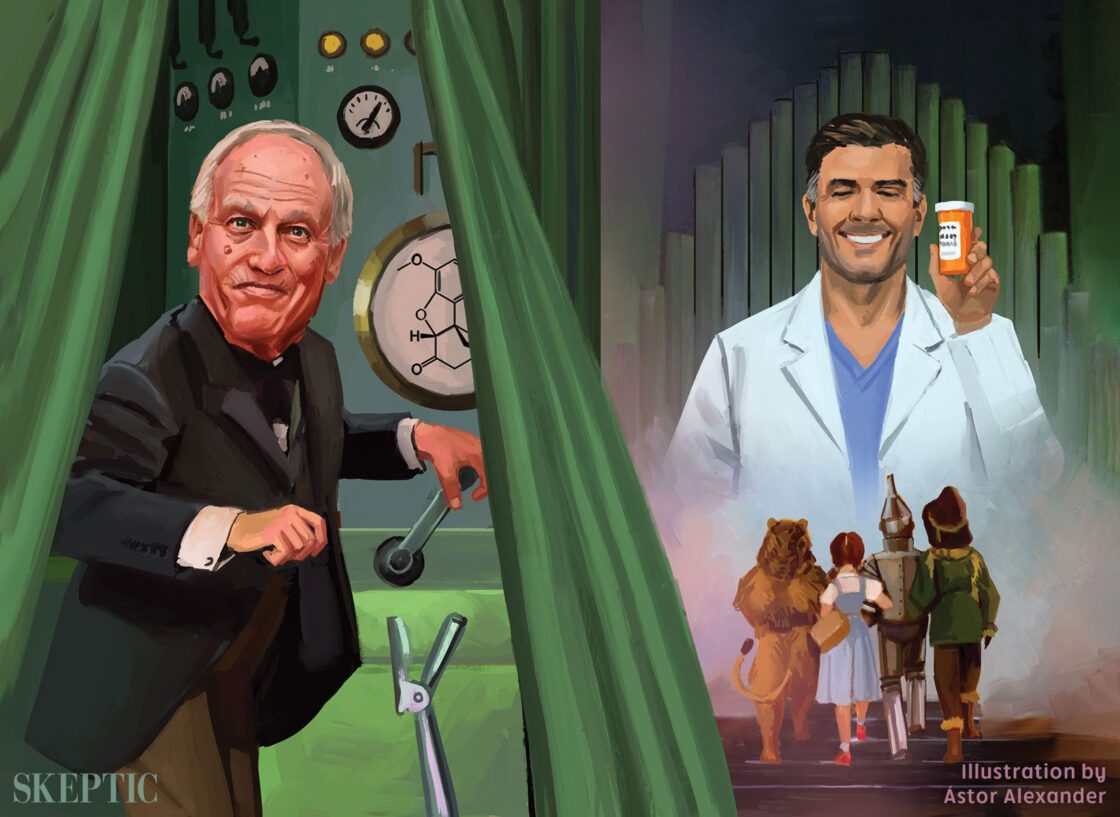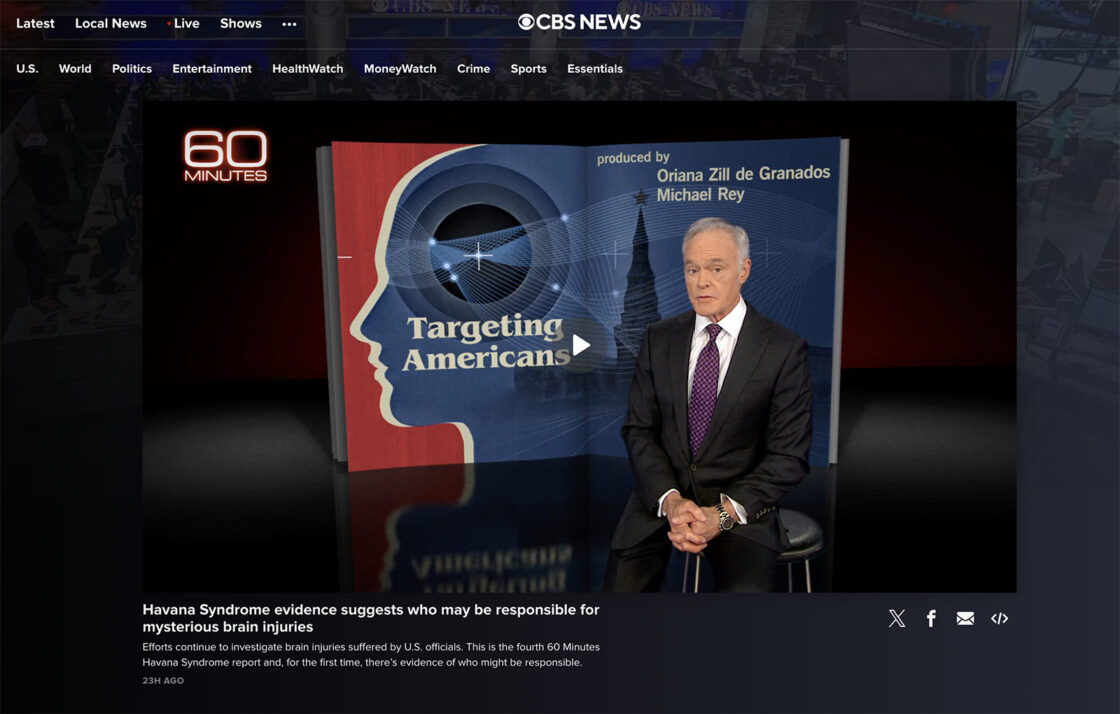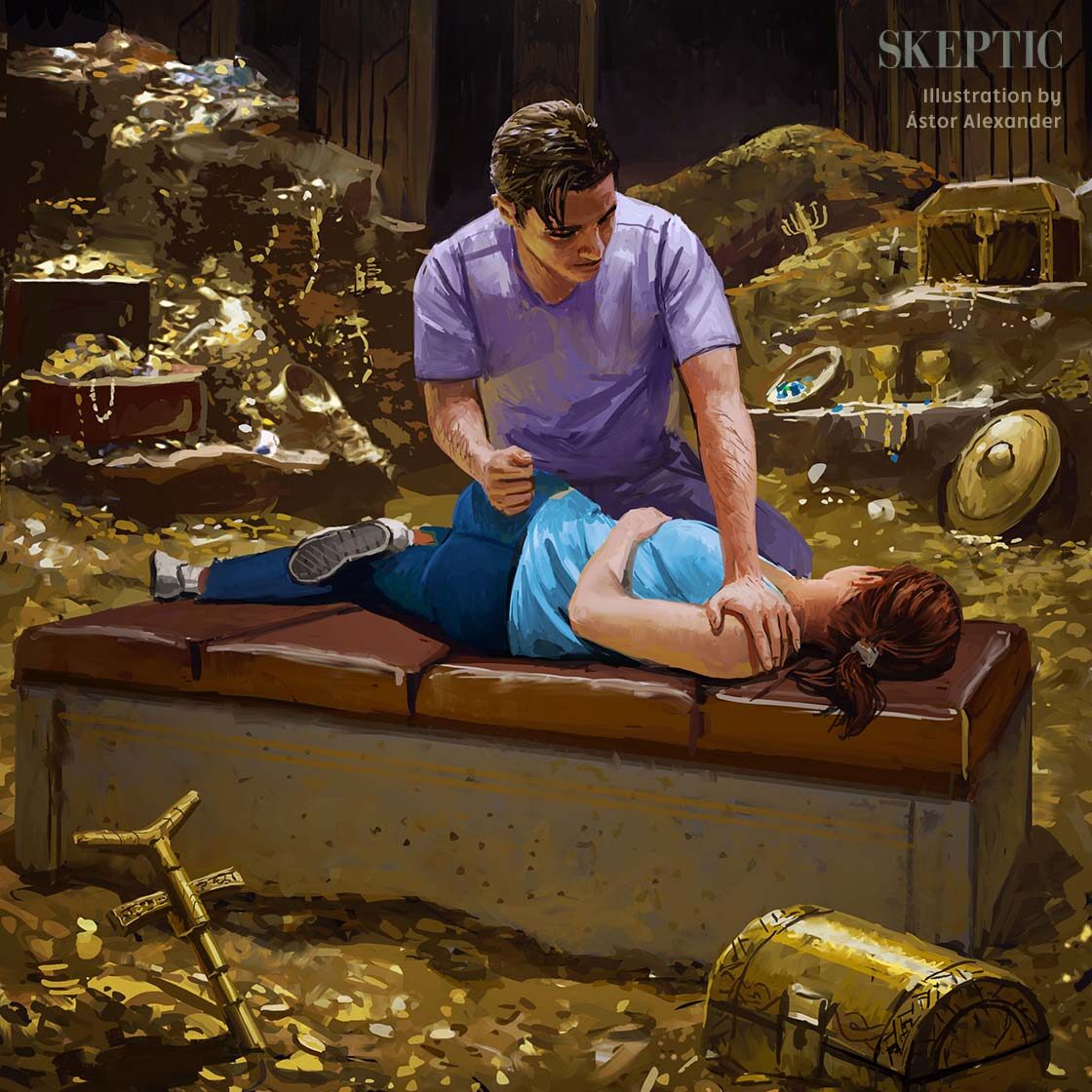“We must have a religious head, one who is the founder, as did Christ, Muhammad, Joseph Smith, Mrs. Eddy, Martin Luther, and others who have founded religions. I am the fountain head. I am the founder of chiropractic in its science, in its art, in its philosophy and in its religious phase.”
Chiropractors vigorously deny the charge that its purported founder, Daniel David Palmer (or D.D. Palmer as commonly referenced), copied osteopathy. Yet, the two schools of thought were nearly identical at their beginnings, and just a few hours apart by railway. Further, chiropractic was “discovered” the same year—1895— that the first class of the American School of Osteopathy (ASO) was graduated. Chiropractors dismiss the sudden emergence of chiropractic so near in time and space to the ASO as a one-in-a-million coincidence. Statisticians, on the other hand, infer that one-in-a-million is not a coincidence.
From their side, prominent osteopaths reported Palmer’s distinctive barrel-chested presence at the ASO, escorted by his well-known friend, neighbor, and osteopathic student James A. Strothers.1, 2 No paper trail or other hard evidence of such visits has been found; for example, there are no train tickets, no local newspaper travel reports, and no lodging or guest signatures in Kirksville.
According to osteopathic tradition, Andrew Taylor Still (MD by apprenticeship) discovered osteopathy in 1874. He still practiced for a number of years before founding the ASO with its first class in 1892.
The coincidence is fantasy. Just as the scientific method is shifting from Popperian falsification to Bayesian probabilities of causes, so too must historical research shift from description alone to proffering the best explanation for historical observations.3–5 Given that, Palmer’s chiropractic “discovery” without any influence or context is nonsensical inasmuch as all discoveries and inventions have antecedents. And aside from the ASO, the Upper Mississippi River Valley was then a hotbed of healers of all kinds. It is more likely that Palmer assimilated osteopathy from the ASO. That, in turn, begs the compelling counterfactual question: would there be a chiropractic profession without the ASO, A.T. Still, and James A. Strothers? I believe not.
Yet today, Palmer and son’s writings are read with reverence and cited to settle arguments among chiropractors. Palmer’s idea that nerves carry vital energy (neurovitalism) keeps chiropractic outside the pale of modern health care delivery and encourages chiropractors to make extravagant claims and allege scientific and professional discrimination.3 Most damaging to the profession is that chiropractic research has the unspoken but understood task of justifying Palmer’s ideas, rather than testing other hypotheses that might lead to increased predictability of treatment effectiveness.
Palmer founded his Palmer School and Cure in 1897 to train others in neurovitalism and spinal manipulation. In 1902, he turned the enterprise over to his son B.J. Palmer, who asserted that chiropractic treatment worked from Above Down and Inside Out (ADIO), that is, from the brain, down the spinal cord, and out through spinal nerves into the body. (According to Joseph Keating, ADIO was originally expressed by A.T. Still as an osteopathic principle). Disappointing research led chiropractic seminars to turn ADIO itself upside down and inside out to diagnose and treat the brain with spinal manipulation, a practice called “functional neurology.”6–8 Thus, ADIO quietly transformed into Outside-In and Down-to-Above (OIDA?), while maintaining the idea of nerves as the conductors of health signals. OIDA turns efference into afference, motor to sensory, and challenges the entire corpus of proven neuroscience findings.
1895
According to official chiropractic history, D.D. Palmer discovered chiropractic in 1895. This kicked off their legendary view of Palmer as a singular genius, whose inspired ideas are not open to question. Even today, most chiropractors prefer Palmer’s notions of neurovitalism and subluxations to modern, empirically verifiable explanations.9
Medical sociologist Walter Wardwell noted that Palmer and his followers believe Palmer founded chiropractic as if “fully formed out of the head of Zeus.”10–12 There are two main versions of his creation myth. In one, Palmer is said to have restored the hearing of a deaf man by thoracic manipulation. In another, Palmer received instruction in chiropractic from a dead Davenport medical physician named Jim Atkinson. The Atkinson story, in turn, came in two versions.
In the first, Palmer directly communicated with the spirit of Jim Atkinson at a Missouri prayer meeting. In the other, dead Jim Atkinson gave Palmer’s fourth wife the details of chiropractic after she awakened from a 19-hour morphine-induced coma.13 Atkinson chose Palmer to convey to the world a new form of healing that was “too advanced for medicine” during Atkinson’s own lifetime 50 years earlier.14, 15
Even though osteopathy and chiropractic were discovered, respectively, in 1874 and 1895, spinal manipulation had already been around for more than 2500 years on nearly every continent. The idea of neurovitalism (also known as vertebral and neurocentric vitalism) was already 200 to 300 years old.16
As craft guilds died out, the industrial revolution reduced work into repetitive tasks that engendered boredom and endangered musculoskeletal injuries, and much of what we now diagnose and treat as repetitive stress and strain syndrome. Bonesetters and other joint manipulators provided some temporary relief, while American medicine did not.
Miserable American Medicine
America lagged behind Europe by almost a century in moving towards science-based medicine. Napoleon Bonaparte was a powerful disruptor to “comforting” physician-based medicine. In planning his conquests, he replaced physicians with surgeons to meet emergency battlefield needs and hospital recovery. Physicians—college-educated elitists who were forbidden to touch blood—were out and surgeons were in. Napoleon shifted French health care delivery to a scientific approach called Paris Medicine.17 Hospitals were converted from palliative care to trauma care. In another paradigm shift, medicine traced diseases to organ dysfunction.18 As each step progressed towards the findings of empirical science, medicine moved away from individual differences and towards increasing predictive power of diagnosis and treatment by disease type.19
The basic tools of 19th century American medicine were guided by the Materia Medica of the day. Treatments included bloodletting (often with leeches) and imbibing mercury compounds.10–12, 20 For self-care, pharmacies sold tonics, soaps, and toothpastes of opium, morphine, heroin, and radium.21, 22 Census records from 1890 list unrecognizable and rare diseases by today’s standards: consumption, “stomach” cancer, apoplexy, and inanition (lack of mental and spiritual vigor).23 Sanitoriums were filled with patients with real, imagined, or misdiagnosed mental illness. At the Still-Hildreth Osteopathic Sanatorium in Macon, Missouri, 88 percent of patients were said to suffer from psychiatric or neuropsychiatric diseases. Substance abuse added another three percent.24
American medicine was so dangerous that physician Oliver Wendell Holmes asserted in 1841 that humanity would be better off if the Materia Medica were sunk “to the bottom of the sea”— though it would kill the fish.17 It is estimated that during the American Civil War, limitations and failures of medicine accounted for two-thirds of 750,000 deaths and many more morbidities.25, 26
Most chiropractors prefer palmer’s notions of neurovitalism and subluxations to modern, empirically verifiable explanations.
Physicians of the day imputed a quaint link between lifestyle and syphilis. They diagnosed by lifestyle27 and treated accordingly: “Billiard markers, some actors, barmaids, actresses, and commercial travelers who drink freely and sit up late” constituted one type. Another was composed of, “the light-haired degenerate lady who sits up all night playing the piano at suburban parties.”28 Depending on “type,” the syphilitic patient was administered a certain color mercury compound. Inducing malaria’s high fever was another medical tool to treat syphilis.29, 30 The medical alternatives were either death from mercury poisoning or death by syphilis.
Palmer Learns Osteopathy
The acrimony of the charge that Palmer visited the ASO in Kirksville has distracted both osteopaths and chiropractors from the more likely event that the ASO regularly visited Palmer in the person of James A. Strothers. Strothers confided in Davenport osteopath O.E. McFadon that he had tutored Palmer.1 Railroad service of 1895 made travel between Davenport and Kirksville easy.
Strothers had signed a confidentiality agreement with Still and the ASO, promising not to teach osteopathy while a student. When Strothers died in 1902 from an unknown abdominal ailment, Palmer was free to weave his discovery myths. Though Palmer admitted he had studied osteopathy in the past, he left it deliberately vague as to just when:
Some years ago I took an expensive course in Electropathy, Cranial Diagnosis, Hydrotherapy, Facial Diagnosis, and later Osteopathy [that] gave me such a measure of confidence as to almost feel it unnecessary to seek other sciences for the mastery of all curable diseases, and having been assured that the underlying philosophy is the same as that of osteopathy…. Chiropractic is osteopathy gone to seed.31
For a brief time in 1911 or 1912, Palmer had a business partner, Alva Gregory, MD, in Oklahoma City. Together, they were going to establish the Palmer-Gregory College of Chiropractic. Dr. Gregory was impressed with spinal manipulation, but not with Palmer. Gregory said that D.D. Palmer and his son B.J. exhibited “gross errors” in understanding human biology,32 and pressed how such an “uneducated” person as Palmer could have discovered chiropractic. Interestingly, Gregory, who produced two books on the subject,32, 33 wrote that Palmer admitted that an osteopath named “Struthers” taught him. The MD wrote, “We find no evidence whether he [Palmer] was the discoverer, but [rather] find facts to the contrary.”32
As Gregory had spelled “Strothers” phonetically as “Struthers,” Palmer’s plagiarizing was hidden for 125 years. Strothers died a decade before Palmer and Gregory met.
The Caster Dynasty: Magnetic Mentors of Still and Palmer
Paul Caster was born in Henry County (or Wayne County, depending on source), Indiana in 1827. His mother died when Paul was 14 years old. He quit school in part because of a serious speech impediment and other “disabilities that made learning difficult.”35 He wandered alone around Elkhart County, Indiana, where he said (and she said) he healed a young woman of her breast cancer. She went on to have a family and live a long and happy life.34, 35 Caster eventually made his way to Ottumwa, Iowa, where he was bestowed the title of doctor for his healing work. In 1869, he began construction on a hospital that, adjusted for inflation, cost $23.5 million in 2022 dollars. The Caster Clinic was an impressive four-story hospital-hotel, which drew patients from more than 30 American states.34 A.T. Still visited the Caster Clinic in the early 1870s. Paul Caster declared Still had “the gift” of magnetic healing and encouraged him to practice.
If california failed to license chiropractic, palmer planned to declare chiropractic a new religion with himself as its “religious head.”
D.D. Palmer lived in What Cheer, Iowa52 from 1876 until 1885 where he opened a grocery. Also in What Cheer, lived Paul Caster’s son J.S., who taught Palmer magnetic healing. Both J.S. and Palmer moved to Burlington, Iowa in 1885 to practice magnetic healing. Palmer left Burlington in late 1887 and moved to Davenport, Iowa.36–38
Whether Palmer and Caster practiced together in Burlington is unclear. Perhaps Palmer and Still crossed paths during their separate mentorships with Caster. Years later, Paul Caster’s grandson, Charles Caster, became a chiropractor and taught at the Palmer School.34, 37
Magnetic Healing
Magnetic healing was also called mesmerism, after the famous promoter, Anton Mesmer, MD, of Vienna, who practiced “animal magnetism” in Paris in the 1780s. Magnetic healing has nothing to do with magnets and not much to do with healing. The idea is to move vital energy to damaged parts of the body that need it for repair and recovery. So scandalous were the Parisian ladies swooning at group magnetic healings in Paris, that French King Louis XVI appointed a special commission to study the merits of magnetic healing. The American ambassador to France, Ben Franklin, was a distinguished member. Prior to the inquiry, Franklin laid out his expectations in a letter to the king on March 19, 1784:
There are in every great rich City a Number of Persons who are never in health, because they are fond of Medicines and always taking them, whereby they derange the natural Functions, and hurt their Constitutions. If these People can be persuaded to forbear their Drugs in Expectation of being cured by only the Physician’s Finger or an Iron Rod pointing at them, they may possibly find good effects tho’ they mistake the Cause.39
The king’s commission found nothing in Mesmer’s magnetic healing beyond belief and confidence in the provider, a familiar theme in today’s allopathic and alternative medicines.40–42 After that finding, Mesmer was banished from Paris. Thus in 1784, Franklin and the commission had accomplished the world’s first clinical trial.43
Bonesetting, Spinal Manipulation, and Neurovitalism
Magnetic healing was based on the belief that matter is animated by spirit, referred to as vitalism. Vitalism had been a handy explanation for health and disease since Aristotle.44 However useful and popular it was to convey concepts of health and disease, the vitalism paradigm increasingly interfered with scientific progress.45, 46 The beginning of the end of vitalism struck in 1827, when German physician and scientist Friedrich Wohler synthesized organic urea from inorganic compounds, instead of from organic ones.45
Vitalism remains popular today as a hopeful, self-empowering paradigm, unchanging in a fast-changing world.19 Whereas scientists and physicians offer educated—even elitist—complex explanations of health and disease, vitalism is conveyed in plain language.47–49 Alternative medicine is the persistent vestige of vitalism.
Hippocrates (460 BCE to 375 BCE), was a proponent of spinal manipulation. His interest in the spine led to his becoming known as the Father of Spine Surgery.50 He practiced spinal manipulation and invented a bench to assist in manipulating.51 In 1580, 1656, and 1674, the first textbooks on spinal manipulation were published.51 In 1871, British physician Wharton Hood published a comprehensive manual on the subject. The topic was of such interest and importance as to be the theme of the 1882 British Medical Association conference.51 English bonesetter John Atkinson, made well publicized and attended visits to Chicago in 1897 and 1898.14 Spinal manipulation was ancient, but acutely interesting in the 300 years leading up to Palmer’s discovery.
By 1906, Palmer was getting in trouble with state medical and osteopathy licensing laws. He claimed that only chiropractic treated nerves, while medicine and osteopathy did not. Some of Palmer’s inspiration may have come from the news of the 1906 Nobel Prize in Medicine to Golgi and Cajal for “work on the structure of the nervous system.”52 Such would be the avant garde and intimidating “rocket science” of its day, a safe place to keep and grow chiropractic until data eventually caught up.
Thus did neurovitalism become central dogma from which chiropractors, their lobbyists, educators, handlers, thought leaders, futurists, justifiers, researchers, and enablers could not escape for the next 125 years. In their research, the nerve paradigm failed to predict and affect even the lowest of low hanging clinical fruit—uncomplicated lower back pain.53, 54
In 1987, chiropractors won an anti-trust lawsuit against the American Medical Association’s long campaign to “contain and eliminate chiropractic.” The ruling judge admonished chiropractic profession to perform the necessary research required of any health care profession.47 When the research failed to vindicate Palmer and neurovitalism, many practicing chiropractors returned to their 19th century neurovitalistic explanations.9, 48
The Religious Head of Chiropractic
In spite of ADIO’s heaven and earth overtones, B.J. Palmer said that chiropractic was the antithesis of Christianity. No deity or soul was required,47, 48, 55 as God was directly accessible through chiropractic care.47, 56 Meanwhile, the senior Palmer was living in California, and state licensing was under consideration. If California failed to license chiropractic, Palmer planned to declare chiropractic a new religion with himself as its “religious head.” In a letter to chiropractor P.W. Johnson of Los Angeles in 1911, D.D. said:
We must have a religious head, … as did Christ, Muhammad, Joseph Smith, Mrs. Eddy, Martin Luther, and others who have founded religions.55
Palmer’s label “chiropractic” was one among several offered by his friend in Davenport, the Reverend Samuel Weed. The word was Greek for “hand practice,” and reflected Palmer’s interest palm reading, or chieromancy.47 As with that esoteric practice, chiropractors could “read” the health of the body by palpating the spine.47
Some Christians mistrusted chiropractors because pain and suffering purified the soul, and chiropractors might remove that pain.47, 48
Chiropractic Wins Neurovitalism but Loses Scientific Agility and Respect
In 1902, the year Strothers died, D.D. Palmer left Davenport and turned his Palmer School and Cure over to his son. D.D. moved on to start schools in Oklahoma, Kansas, Oregon, and Santa Barbara, CA. He practiced in Pasadena, CA where he was put on trial for the deaths of two patients.53 Palmer died in Los Angeles on October 20, 1913 of typhoid fever.53
By 1936, Willard Carver crystallized the official chiropractic dogma in “The History of Chiropractic.” Carver flatly stated that osteopathy was “nothing more than a slight advance over” Mesmer’s magnetic healing.64 By then, the fact that osteopathy and chiropractic both had roots in magnetic healing was conveniently forgotten.
Below is an excerpt from a chiropractor’s website obtained in 2022, making the case for neurovitalistic treatment of the brain. Easily thousands of chiropractic websites worldwide tout neurovitalism as the reason for chiropractic care.
CHIROPRACTIC CARE IMPACTS EVERY CELL, TISSUE AND ORGAN The general public typically doesn’t understand the impact chiropractic care has on every cell, tissue, and organ in our bodies. As they discover this truth, many lives are now being improved and even saved. Take for example the topic of mental health. Many people suffer from things like anxiety, depression, bipolar disorder, and schizophrenia to name a few, but most people don’t realize there are alternative options to help improve your mental health naturally. Chiropractic care isn’t usually an alternative option to mental health that people think about. The truth is, chiropractic care has been improving mental health of many people since the early 20th century.57
Meanwhile, osteopaths moved on from magnetic healing, and became mainstream health care providers with 38 osteopathic schools across the U.S., many supported within public universities. Osteopaths in America offer primary care, and some consider manipulation as one clinical tool. By contrast, chiropractic never let go of the neurovitalism central dogma while private chiropractic colleges in North America continue to graduate about 2000 chiropractors per year to a saturated market.58
Conclusion
The tragic flaw that plagues the chiropractic profession lies in its members’ devotion to the idea that chiropractic is D.D. Palmer’s unique discovery. Deference to Palmer’s superior intellect and spiritual revelation have encouraged a belief among chiropractors that they are victims of prejudice and discrimination from medicine. Chiropractic “research” has been greatly influenced, if not limited to, justification of Palmer’s ideas.

This article appeared in Skeptic magazine 27.3
Buy print edition
Buy digital edition
Subscribe to print edition
Subscribe to digital edition
Download our app
If there is any value in chiropractic adjustments it may lie not in the treatment itself, but rather in steering patients away from expensive and risky surgeries and potential dependence on pain killing drugs. Chiropractors offer confident explanations that reduce the fear and anxiety of back pain and motivate patients to engage in self-care and exercise.40–42 Apart from social and psychological support, the value of chiropractic treatment per se remains equivocal. There is no homogeneous diagnostic group and no standard chiropractic treatment. Quasi-experimental designs might be helpful.59
So far, spinal manipulation studies have yielded, at best, weak evidence.40–42 However, as complex as the facets of back pain may be,60, 61 the answer, in most cases, is simple. My meta-analysis showed 97 percent of acute back pain resolves with the passage of time, some attention, and regular exercise.40–42 It was not well received. ![]()
About the Author
Michael Menke was a chiropractor and chiropractic researcher in Northern California for 20 years. He is now a methodologist and measurement expert in health economics and outcomes research in the US, and formerly head of medical psychology in Kuala Lumpur, Malaysia. His research includes evaluating effective smoking cessation programs, gestational diabetes, accuracy of disease screening, traumatic brain injury, colorectal cancer, accuracy of salivary biomarkers, early detection of Parkinson’s disease, and low back pain. His PhD is from University of Arizona Department of Psychology and School of Pharmacy.
References
- McFadon, O.E. (1970). An Early Peek at Chiro-Klepto. The Osteopathic Physician. 37(2)
- Hildreth, A.G. (1938). The Lengthening Shadow of Dr. Andrew Taylor Still. The Journal Printing Company.
- https://bit.ly/3MV1szg
- Robert, C.P. (1994). The Bayesian Choice: a Decision-theoretic Motivation. (p. 436) Spinger-Verlag.
- https://bit.ly/39vvHz1
- https://bit.ly/3zMEC9Q
- https://bit.ly/3NZ9GYy
- https://bit.ly/3xRSFcY
- https://bit.ly/3OliiZf
- Wardwell, W.I. (1992). Chiropractic: History and Evolution of a New Profession. Mosby.
- Wardwell, W.I. (1994). Alternative medicine in the United States. Social Science & Medicine (1982), 38(8), 1061–1068. https://doi.org/10.1016/0277-9536(94)90223-2
- Wardwell, W.I. (1994). Differential Evolution of the Osteopathic and Chiropractic Professions in the United States. Perspectives in Biology and Medicine, 37(4), 595–608. https://doi.org/10.1353/pbm.1994.0013
- Foley, J.D. (2016). DD Palmer’s Second Book: The Chiropractor 1914—Revealed. Chiropractic History, 36(1), 72.
- Bovine, G. (2013). John Atkinson (1854–1904), The English Bonesetter of Park Lane: His Visit to America, Bonesetting Techniques, and the Atkinson Connection to Chiropractic. Chiropractic History, 33(1).
- https://bit.ly/3MScPYD
- Ober, W.B. (1976). American Pathology in the 19th Century: Notes for the Definition of a Specialty. Bulletin of the New York Academy of Medicine, 52(3), 326.
- McCullough, D. (2011). The Greater Journey. Simon & Schuster.
- Reiser, S.J. (1995). Anatomic thinking: The clinical and social consequences of health care’s basic logic. Family and Community Health, 26–36.
- Nirenberg, D. & Nirenberg, R.L. (2021) Uncountable: A Philosophical History of Number and Humanity From Antiquity to the Present. The University of Chicago Press.
- North, R.L. (2000). Benjamin Rush, MD: assassin or beloved healer?. In Baylor University Medical Center Proceedings (Vol. 13, No. 1, pp. 45–49). Taylor & Francis.
- https://bit.ly/3zEBzAx
- Macklis, R.M. (1990). Radithor and the era of mild radium therapy. JAMA, 264(5), 614–618.
- https://bit.ly/3xyrTVw
- Ching, L.M. (2014). The Still-Hildreth Sanatorium: A history and chart review. AAO Journal, 24(4), 12–25.
- Hacker, J.D. & McPherson, J.M. (2011). A census-based count of the civil war dead: With introductory remarks by James M. McPherson. Civil War History, 57(4), 307–348.
- Reilly, R.F. (2016). Medical and surgical care during the American Civil War, 1861–1865. In Baylor University Medical Center Proceedings (Vol. 29, No. 2, pp. 138–142). Taylor & Francis.
- Shockman, S., Buescher, L.S., & Stone, S.P. (2014). Syphilis in the United States. Clinics in Dermatology, 32(2), 213–218.
- Milner, E. (1887). Quarterly Compendium of Medical Science, a Synopsis. Inquirer Printing Company.
- https://bit.ly/3OigzUi
- Zuckerman, M.K. (2016). More Harm than Healing? Investigating the Iatrogenic Effects of Mercury Treatment on Acquired Syphilis in Post-medieval London. Open Archaeology, 2(1).
- Leach, R. (2004). The Chiropractic Theories: A Textbook of Scientific Research. Lippincott, Williams, and Wilkins.
- Gregory, A.A. (1912). Spinal treatment: auxiliary methods of treatment designed for the use of those who believe and appreciate the true principle of progress in the healing art, namely, try all things with an open mind, and hold fast to that which is found to be good. The Palmer-Gregory College.
- Gregory, A.A. (1913). Rational therapy: A manual of rational therapy methods embracing a brief description of the etiology, pathology and symptomatology of disease and written with special reference to the application of rational therapy in the treatment of disease, 2nd Edition. The Palmer-Gregory College.
- Waters, T. (2020). The Casters—Magnetic Healers, 2nd Edition. Lulu.
- Gue, B.F., & Shambaugh, B.F. (Eds.). (1899). Biographies and Portraits of the Progressive Men of Iowa: Leaders in Business, Politics and the Professions; Together with an Original and Authentic History of the State, by Ex-Lieutenant- Governor BF Gue. Conaway & Shaw.
- https://bit.ly/3MOa1M8
- https://bit.ly/3MOmsrr
- https://bit.ly/3HtRBzq
- https://bit.ly/3MUDwfd
- Menke, J.M. (2014). Manual therapy researchers are misled by natural history and placebo effects. Spine, 39(23).
- Menke, J.M. (2014). Do manual therapies help low back pain? A comparative effectiveness meta-analysis. Spine, 39(7).
- Menke, J.M. (2015). Deconstructing the Tower of Back Pain Babel. Physical Therapy Reviews, 20(4), 262–263.
- Holbrook, M.L. (1896). Franklin on drugging and Mesmerism. Journal of Hygiene.
- Coulter, I., Snider, P., & Neil, A. (2019). Vitalism–a worldview revisited: a critique of vitalism and its implications for integrative medicine. Integrative Medicine: A Clinician’s Journal, 18(3), 60.
- Lane, N. (2005). Power, Sex, Suicide: Mitochondria and the Meaning of Life. Oxford University Press.
- Kuhn, T.S. (1962). The Structure of Scientific Revolutions. University of Chicago Press.
- Brown, C.G. (2010). Chiropractic and Christianity: The Power of Pain to Adjust Cultural Alignments. Church History, 79(1), 144–181.
- https://bit.ly/3QnxWVL
- Simpson, J.K., & Young, K.J. (2020). Vitalism in Contemporary Chiropractic: A Help or a Hinderance?. Chiropractic & Manual Therapies, 28(1), 1–20.
- Marketos, S.G., & Skiadas, P. (1999). Hippocrates: The Father of Spine Surgery. Spine, 24(13).
- Pettman E. (2007). A History of Manipulative Therapy. The Journal of Manual & Manipulative Therapy, 15(3), 165–174. https://doi.org/10.1179/106698107790819873
- https://bit.ly/3b4Ip8n
- Valdivia, J. (2017). The Last Ten Years of D.D. Palmer, “As I See It.” Chiropractic History, 37(2).
- Troyanovich, S.J., & Keating Jr, J.C. (2005). Wisconsin versus Chiropractic: The Trials at La Crosse and the Birth of a Chiropractic Champion. Chiropractic History, 25(1).
- https://bit.ly/3tDoILi
- Fuller, R.C. (2001). Spiritual but Not Religious: Understanding Unchurched America. Oxford University Press.
- https://bit.ly/3QqCkU0
- https://bit.ly/3Hrxf9F
- Shadish, W.R., Cook, T.D., & Campbell, D.T. (2002). Experimental and Quasi-Experimental Designs for Generalized Causal Inference. Houghton, Mifflin and Company.
- Mitchell, S.D. (2009). Unsimple Truths: Science, Complexity, and Policy. University of Chicago Press.
- Richters, J.E. (1997). The Hubble Hypothesis and the Developmentalist’s Dilemma. Development and Psychopathology, 9(2), 193–229.
This article was published on January 24, 2023.

















